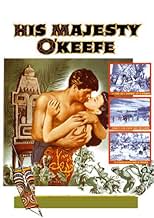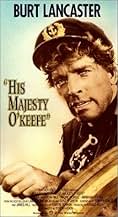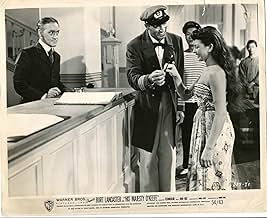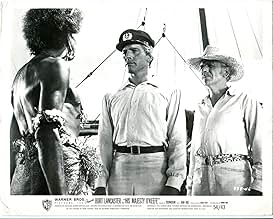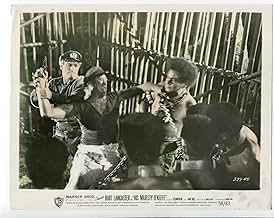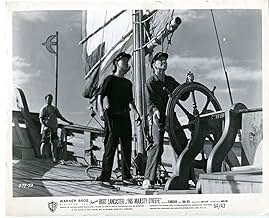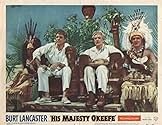IMDb RATING
6.1/10
1.5K
YOUR RATING
A Yankee sea captain has adventures in paradise trying to become an entrepreneur in Micronesia.A Yankee sea captain has adventures in paradise trying to become an entrepreneur in Micronesia.A Yankee sea captain has adventures in paradise trying to become an entrepreneur in Micronesia.
André Morell
- Alfred Tetins
- (as Andre Morell)
Jimmy Dime
- Sailor at Table in Saloon
- (uncredited)
Sol Gorss
- Tough Sailor in Fight
- (uncredited)
Hugh McLardy
- Hong Kong Tailor
- (uncredited)
Paddy Mulelly
- J.R. Beldon, Bank Manager
- (uncredited)
Storyline
Did you know
- TriviaAlthough heavily Hollywoodized, the film is based on real individuals and events. There is a boutique hotel in Yap named after him (O'Keefe's), and the style of construction reflects the architecture of O'Keefe's time.
- GoofsO'Keefe returns to Hong Kong and stock footage is shown of people walking down a street. However, the movie is set in the 1870s and the footage is of 1950s Hong Kong. Giveaways include signs such as "No Motors".
- Quotes
Capt. David O'Keefe: Goodbye, Fatumak. Thank you for everything. Goodbye!
Fatumak, Medicine Man: There are no goodbyes between friends.
[handing him a necklace]
Fatumak, Medicine Man: This is the whale's tooth of remembrance until we meet again.
- ConnectionsFeatured in A Fellow Journeyman: Byron Haskin at Paramount (2022)
Featured review
Captain David O'Keefe was a real-life person, a 19th century Irish-born adventurer from Savannah, Georgia, who made his fortune in the copra trade on the South Pacific island of Yap. This film is a fictionalised version of his life-story, and as one might expect takes a few liberties with history. In the film O'Keefe becomes king of Yap and defends his people against the incursions of aggressive German colonisers. In reality, when O'Keefe arrived on the island in 1871 it was a Spanish colony and the newly-united German Empire had no interest in acquiring colonies in the South Pacific or anywhere else. Yap did not become German until 1899, well after the date at which the film is set. This change was possibly made because in 1954, only nine years after the end of the war, American audiences would have been more accustomed to seeing Germans than Spaniards as cinematic villains. The film does, however, provide one "good German" in the shape of O'Keefe's friend Alfred Tetens, another real-life person.
O'Keefe did indeed marry a local girl as shown here, but the film tactfully omits the fact that their marriage was invalid because he already had a wife in Savannah. The Production Code officially forbade the depiction of racially mixed marriages or romances, but by the fifties there seemed to be an unofficial relaxation of this rule in force. Relationships between white men and non-white women could be shown provided (a) the girl was described as being of mixed race and (b) she was played by a white actress. This rule was applied in "Showboat" and "Love is a Many-Splendoured Thing", and is also applied here. O'Keefe's sweetheart Dalabo, supposedly of mixed European and Micronesian descent, is played by the Derbyshire-born Joan Rice. Dalabo has a rival for O'Keefe's affections, but the said rival, being pure- blooded Yapese, has to lose out.
Rice, although undoubtedly decorative to look at, is never really convincing as a native of the South Seas, or for that matter of any part of the world further south than Derbyshire. Burt Lancaster, however, makes an agreeable hero, and receives good support from André Morell as Tetens. Later in his career Lancaster could be a very intense actor, often appearing in dramas with a serious social, political or philosophical purpose, but in his action films of the early fifties his style of acting was generally much more relaxed, and so it is here.
Many film-makers of the early days of the cinema were reluctant to venture too far away from a Hollywood studio, even when their films were ostensibly set in some exotic part of the globe. This attitude still prevailed in some quarters during the fifties; for example "Brigadoon", also made in 1954, had to be shot on MGM's sound stage, against a vast painted backdrop of Scottish-style scenery, because Dore Schary was reluctant to stump up the cost of transporting cast and crew all the way to Scotland, or even to some part of America that looked like Scotland. In other quarters, however, attitudes were changing as the studios began to realise that local colour and authentic scenery could be useful weapons in their battle against the new enemy, television.
"His Majesty O'Keefe" is a case in point, as much of the film was actually shot on location in the South Pacific. This doubtless increased the budget, but I think that the decision was the right one, as the result was a colourful, visually attractive film. Byron Haskin is unlikely to feature very highly on any list of Hollywood's great auteurs, but he was capable of producing some very decent and enjoyable adventure films (his 1953 version of "The War of the Worlds" is probably the best known) and this is another in that category. 7/10
O'Keefe did indeed marry a local girl as shown here, but the film tactfully omits the fact that their marriage was invalid because he already had a wife in Savannah. The Production Code officially forbade the depiction of racially mixed marriages or romances, but by the fifties there seemed to be an unofficial relaxation of this rule in force. Relationships between white men and non-white women could be shown provided (a) the girl was described as being of mixed race and (b) she was played by a white actress. This rule was applied in "Showboat" and "Love is a Many-Splendoured Thing", and is also applied here. O'Keefe's sweetheart Dalabo, supposedly of mixed European and Micronesian descent, is played by the Derbyshire-born Joan Rice. Dalabo has a rival for O'Keefe's affections, but the said rival, being pure- blooded Yapese, has to lose out.
Rice, although undoubtedly decorative to look at, is never really convincing as a native of the South Seas, or for that matter of any part of the world further south than Derbyshire. Burt Lancaster, however, makes an agreeable hero, and receives good support from André Morell as Tetens. Later in his career Lancaster could be a very intense actor, often appearing in dramas with a serious social, political or philosophical purpose, but in his action films of the early fifties his style of acting was generally much more relaxed, and so it is here.
Many film-makers of the early days of the cinema were reluctant to venture too far away from a Hollywood studio, even when their films were ostensibly set in some exotic part of the globe. This attitude still prevailed in some quarters during the fifties; for example "Brigadoon", also made in 1954, had to be shot on MGM's sound stage, against a vast painted backdrop of Scottish-style scenery, because Dore Schary was reluctant to stump up the cost of transporting cast and crew all the way to Scotland, or even to some part of America that looked like Scotland. In other quarters, however, attitudes were changing as the studios began to realise that local colour and authentic scenery could be useful weapons in their battle against the new enemy, television.
"His Majesty O'Keefe" is a case in point, as much of the film was actually shot on location in the South Pacific. This doubtless increased the budget, but I think that the decision was the right one, as the result was a colourful, visually attractive film. Byron Haskin is unlikely to feature very highly on any list of Hollywood's great auteurs, but he was capable of producing some very decent and enjoyable adventure films (his 1953 version of "The War of the Worlds" is probably the best known) and this is another in that category. 7/10
- JamesHitchcock
- Dec 12, 2013
- Permalink
- How long is His Majesty O'Keefe?Powered by Alexa
Details
- Release date
- Country of origin
- Language
- Also known as
- East Meets West
- Filming locations
- Viti Levu, Fiji(village of Goloa)
- Production company
- See more company credits at IMDbPro
Box office
- Budget
- $1,550,000 (estimated)
- Runtime1 hour 31 minutes
Contribute to this page
Suggest an edit or add missing content



